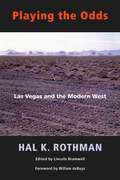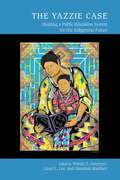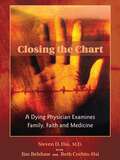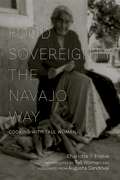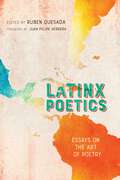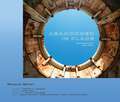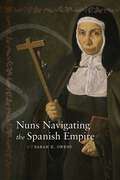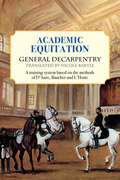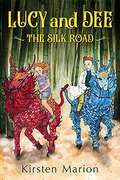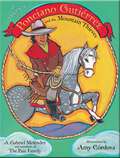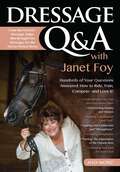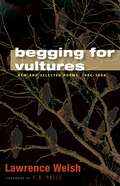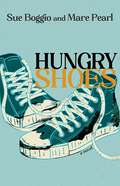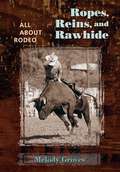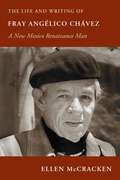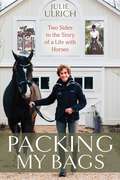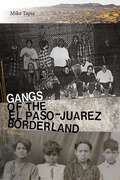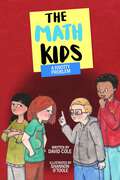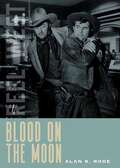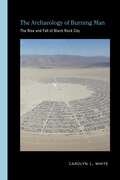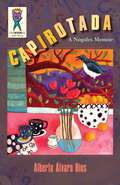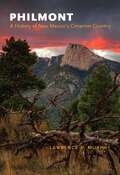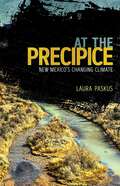- Table View
- List View
House Gods: Sustainable Buildings and Renegade Builders
by Jim KristoficOur buildings are making us sick. Our homes, offices, factories, and dormitories are, in some sense, fresh parasites on the sacred Earth, Nahasdzáán. In search of a better way, author Jim Kristofic journeys across the Southwest to apprentice with architects and builders who know how to make buildings that will take care of us. This is where he meets the House Gods who are building to the sun so that we can live on Earth. Forever.In House Gods, Kristofic pursues the techniques of sustainable building and the philosophies of its practitioners. What emerges is a strange and haunting quest through adobe mud and mayhem, encounters with shamans and stray dogs, solar panels, tragedy, and true believers. It is a story about doing something meaningful, and about the kinds of things that grow out of deep pain. One of these things is compassion—from which may come solace. We build our buildings, we make our lives—we are the House Gods.
Playing the Odds: Las Vegas and the Modern West
by Hal K. RothmanThis collection of Hal Rothman's wide-ranging, brash, and brilliant essays on Las Vegas offers up a treasury of insights on the follies and possibilities of the New West. Confident, passionate, learned and, yes, wise, Rothman is simply one of the most important voices writing on the region today. He is also a hell of a lot of fun to read. - Virginia Scharff, professor of history and Director, Center for the Southwest, University of New Mexico, Albuquerque, and Women of the West chair at the Institute for the Study of the American West, Autry National Center, Los AngelesHal Rothman has been enlightening me, irritating me, surprising me, and making me laugh for twenty years. Reading his columns reminds me why. He has long been one of the brashest, loudest, smartest, and most original voices in the West. Not even ALS could quiet him. These columns aren't the same as talking to him, but they come close. - Richard White, Margaret Byrne Professor of American History, Stanford UniversityHal Rothman is both the greatest Western historian of his generation and an H. L. Mencken in cowboy boots. Here is a magnificent collection of his opinion, wit, and wisdom. - Mike Davis, author of Planet of Slums and Buda's Wagon
The Yazzie Case: Building a Public Education System for Our Indigenous Future (Studies in Indigenous Community Building)
by Wendy S. Greyeyes, Lloyd L. Lee, and Glenabah MartinezThe story of Wilhelmina Yazzie and her son’s effort to seek an adequate education in New Mexico schools revealed an educational system with poor policy implementation, inadequate funding, and piecemeal educational reform. The 2018 decision in the Yazzie/Martinez lawsuit proved what has always been known: the educational needs of Native American students were not being met.In this superb collection of essays, the contributors cover the background and significance of the lawsuit and its impact on racial and social politics. The Yazzie Case provides essential reading for educators, policy analysts, attorneys, professors, and students to understand the historically entrenched racism and colonial barriers impacting all Native American students in New Mexico’s public schools. It constructs a new vision and calls for transformational change to resolve the systemic challenges plaguing Native American students in New Mexico’s public education system.ContributorsGeorgina BadoniCynthia BenallyRebecca Blum MartínezNathaniel CharleyMelvatha R. CheeShiv DesaiDonna DeyhleTerri FlowerdayWendy S. GreyeyesAlex KinsellaLloyd L. LeeTiffany S. LeeNancy LópezHondo Louis (photographer)Glenabah MartinezNatalie MartinezJonathan NezCarlotta Penny BirdPreston SanchezKaren C. Sanchez-GriegoChristine SimsLeola Tsinnajinnie PaquinVincent WeritoWilhelmina Yazzie
Closing the Chart: A Dying Physician Examines Family, Faith, and Medicine
by Steven D. HsiDr. Steven D. Hsi, a family physician and father of two young sons, was diagnosed in 1995 with a rare coronary disease that caused his death five years later at the age of forty-four. Throughout his ordeals as a patient, including three open-heart surgeries, Dr. Hsi's outlook on the teaching and practice of medicine changed. In 1997 he began a journal intended for publication after his death. Written with the assistance of newspaper columnist Jim Belshaw and completed posthumously by Hsi's widow, Beth Corbin-Hsi, Dr. Hsi's writings urge his colleagues to become healers, to look at their patients as human beings with spiritual as well as physical lives.Every patient should read it, if only to be made aware that they are not alone with their thoughts. Every spouse of a patient should read it. . . . Every medical student and physician should read it to learn that the biology of the disease is really just a small part of the illness.--John Saiki, M.D., Medical Oncology, University of New MexicoDr. Steven Hsi asks his fellow doctors to be more than physicians. He asks them to be healers. He says that when he thinks of healers, he sees traditional medicine men, people who are integral parts of their communities. They are in touch physically and spiritually with the people they serve.--Tony HillermanClosing the Chart is built on the personal journals and experiences of Steven D. Hsi, M.D., as he travels on an intense 5-year journey from an assumption of health, professional success, and family stability to his progressive illness and eventual death. . . . Closing the Chart is both an engaging, page-turning read and a story told with so little artifice that you cannot close the cover unchanged.--Kenneth Jacobson, executive director, American Holistic Medical Association, Explore &“There are lessons on every page, lessons to make us better caregivers, more discerning patients, and better advocates for family members and friends who are sick. . . . Every reader will take away different lessons from this book based on his or her role, age, and experience. This would be an ideal book for group study by medical and nursing students with some senior physicians, patients, and family members. What a great learning experience for all participants! . . . I exhort you to pick up and read this humble story. Nothing I have encountered in the medical narrative genre has been more worthy of my time.&” —David J. Elpern, M.D, Psychiatric Services
Food Sovereignty the Navajo Way: Cooking with Tall Woman
by Charlotte J. FrisbieAround the world, indigenous peoples are returning to traditional foods produced by traditional methods of subsistence. The goal of controlling their own food systems, known as food sovereignty, is to reestablish healthy lifeways to combat contemporary diseases such as diabetes and obesity. This is the first book to focus on the dietary practices of the Navajos, from the earliest known times into the present, and relate them to the Navajo Nation&’s participation in the global food sovereignty movement. It documents the time-honored foods and recipes of a Navajo woman over almost a century, from the days when Navajos gathered or hunted almost everything they ate to a time when their diet was dominated by highly processed foods.
Latinx Poetics: Essays on the Art of Poetry
by Ruben QuesadaLatinx Poetics: Essays on the Art of Poetry collects personal and academic writing from Latino, Latin American, Latinx, and Luso poets about the nature of poetry and its practice. At the heart of this anthology lies the intersection of history, language, and the human experience. The collection explores the ways in which a people&’s history and language are vital to the development of a poet&’s imagination and insists that the meaning and value of poetry are necessary to understand the history and future of a people. The Latinx community is not a monolith, and accordingly the poets assembled here vary in style, language, and nationality. The pieces selected expose the depth of existing verse and scholarship by poets and scholars including Brenda Cárdenas, Daniel Borzutzky, Orlando Menes, and over a dozen more.The essays not only expand the poetic landscape but extend Latinx and Latin American linguistic and geographical boundaries. Writers, educators, and students will find awareness, purpose, and inspiration in this one-of-a-kind anthology.
Abandoned in Place: Preserving America's Space History
by Roland MillerStenciled on many of the deactivated facilities at Cape Canaveral Air Force Station, the evocative phrase &“abandoned in place&” indicates the structures that have been deserted. Some structures, too solid for any known method of demolition, stand empty and unused in the wake of the early period of US space exploration. Now Roland Miller&’s color photographs document the NASA, Air Force, and Army facilities across the nation that once played a crucial role in the space race.Rapidly succumbing to the elements and demolition, most of the blockhouses, launch towers, tunnels, test stands, and control rooms featured in Abandoned in Place are located at secure military or NASA facilities with little or no public access. Some have been repurposed, but over half of the facilities photographed no longer exist. The haunting images collected here impart artistic insight while preserving an important period in history.
Nuns Navigating the Spanish Empire (Diálogos Series)
by Sarah E. OwensNuns Navigating the Spanish Empire tells the remarkable story of a group of nuns who traveled halfway around the globe in the seventeenth century to establish the first female Franciscan convent in the Far East.In 1620 Sor Jerónima de la Asunción (1556–1630) and her cofounders left their cloistered convent in Toledo, Spain, journeying to Mexico to board a Manila galleon on their way to the Philippines. Sor Jerónima is familiar to art historians for her portrait by Velázquez that hangs in the Prado Museum in Madrid. What most people do not know is that one of her travel companions, Sor Ana de Cristo (1565–1636), wrote a long biographical account of Sor Jerónima and their fifteen-month odyssey. Drawing from Sor Ana&’s manuscript, other archival sources, and rare books, Owens&’s study offers a fascinating view of travel, evangelization, and empire.
Academic Equitation
by General DecarpentryOriginally written and published in 1949,Academic Equitationwas considered by dressage experts to be the most important contribution to classical training in the twentieth century. This book was intended as a preparation for international dressage competitions but is far more than this. It discusses the subjects of academic equitation, the riding master and the choice of horse before introducing the reader to the author's systematic program, covering the very early training right up to the most advanced movements.The appendix deals with lungeing, work in hand, long reins and pillar work. General Decarpentry was not only a distinguished scholar of artistic equitation but also equally versed in putting the theories into practice. He deals with the education of the young horse and the complications and details of advanced schooling with the hand of a master.Although he claims that nothing in the book is his—his training system is based on the methods of D'Aure, Baucher and L'Hotte—the General's wisdom and deep knowledge are manifest throughout. It was the General's great wish that traditional teachings on the art of equitation should not be lost to those who wished to study equitation. In this most important work he has succeeded in presenting these teachings in such a way that allows both layman and expert to obtain a deeper insight into this fascinating subject.
The Silk Road: Lucy & Dee (Book 1) (Lucy & Dee)
by Kirsten MarionOh, cheer up, said Lucy. It's simple really. We find the Emperor, help him stay alive until he&’s ready to take the throne, get the key for changing lead into gold, and then it&’s off to find your parents. What could go wrong?When a flaming bird leads Lucy and Dee to a hidden road, they meet the lord of stone who offers them a quest. In a new world full of magic, dragons, and demons, all they have to do is befriend a young emperor. Which would be a lot easier if he wasn't a royal pain and an angry queen didn't want to destroy him.With the entitled ruler in tow, Lucy and Dee must find a way home with only a mysterious feather and a dragon-whisperer (who looks suspiciously like a hedgehog) as defenses against capture.
The Legend of Ponciano Gutiérrez and the Mountain Thieves (Pasó Por Aquí Series on the Nuevomexicano Literary Heritage)
by A. Gabriel MeléndezOnce upon a time in the Mora Valley of northern New Mexico there lived a farmer named Ponciano Gutiérrez. On a trip through the mountains he was taken captive by Vicente Silva and his gang of bank robbers. This tale of Ponciano&’s quick-witted escape has been a bedtime story for generations in the Paiz family. New Mexico authors at the turn of the last century published many accounts of the crimes of Vicente Silva. This book is the first to present a Silva legend that has been kept alive by families in Mora since the 1890s. The Paiz family version is presented in English with a Spanish translation by A. Gabriel Meléndez.
Dressage Q&A with Janet Foy
by Janet FoyUSEF S and FEI 4* Dressage Judge Janet Foy issued an invitation to the dressage population: &“Ask me your toughest dressage questions; ask me about the things about riding, training, and competing that you just don&’t understand; or, just ask me the questions you&’re always afraid to ask because you don&’t want to look like you don&’t know what you&’re doing!&” The result was an outpouring of queries, from riders at every level, and from both those who just ride for fun as well as those who show. Foy has earned a dedicated following over many years teaching popular clinics alongside US Olympians Steffen Peters and Debbie McDonald, and her vast knowledge of the sport of dressage and trademark sense of humor propelled her first book Dressage for the Not-So-Perfect Horse to bestseller status. Now, for her eagerly awaited follow-up, she&’s responded to the hundreds of dressage questions she&’s received in an easy-to-engage-with Q-and-A format. Readers find no-nonsense answers to everything from understanding how horses learn the movements to really &“getting&” the importance of the outside rein to gaining coordination and achieving &“throughness.&” As always, Foy&’s enthusiasm emanates from her words, and her drive to provide solid understanding is underscored by her insistence that riding dressage is, above all, fun.
Begging for Vultures: New and Selected Poems, 1994-2009 (Mary Burritt Christiansen Poetry Series)
by Lawrence WelshThe poetry of Lawrence Welsh crosses many borders, from South Central Los Angeles, where he was raised, to El Paso, where he has lived for almost twenty years. A newspaper man turned poet, a punk rock songwriter who became an English teacher, an Irishman at home in Texas, Welsh gives voice to the famous, the infamous, and the forgotten.
Hungry Shoes: A Novel (Lynn and Lynda Miller Southwest Fiction Series)
by Sue Boggio Mare PearlMaddie and Grace meet in an adolescent psychiatric unit after each has committed desperate self-injurious acts in response to years of abuse, neglect, and chaos. Together they navigate the surreal world of their fellow patients while staff provide nurturance and guidance to support their healing journeys. With the help of veteran psychiatrist Mary Swenson, Maddie and Grace come to terms with their pasts and discover the inner fortitude they need to create futures filled with empowerment and hope.
After Party: Poems (Mary Burritt Christiansen Poetry Series)
by Noah BlausteinThe geography of After Party includes married life and fatherhood, a childhood survived if not fully understood, the transition from youth to an adulthood filled with responsibilities, and the dangers of our current world and culture—on a personal and global scale—that can distract and disrupt life and our idea of home. By turns funny and heartbreaking, flirtatious and frank, Blaustein never lets his aggravation or confusion overwhelm his sense of gratitude for the life he leads and those he loves.
Ropes, Reins, and Rawhide: All About Rodeo
by Melody GrovesHeart pounding, blood pumping, the cowboy nods, chute gate opens, and his world begins. Eight seconds of adrenaline rush. Eight seconds of gripping, pulling, and holding on. The animal under him bucks and twists attempting to dislodge the cowboy's seat but the rider sticks like glue. The buzzer sounds, the cowboy dismounts, tips his hat to a cheering crowd, and nods at his proud fellow riders. Just another day at the office.--from Ropes, Reins, and RawhideMelody Groves, a native New Mexican and former bull rider, examines the sport of rodeo, from a brief history of the ranch-based competition to the rodeos of today and what each event demands. One of the first topics she addresses is the treatment of the animals. As she points out, without the bulls or horses, there wouldn't be a rodeo. For that reason, the stock contractors, chute workers, cowboys, and all the arena workers respect the animals and take precautions against their injuries.Groves writes for the rodeo novice, explaining the workings and workers (stock handlers, veterinarians, clowns, pick up men, event judges, etc.) seen in the arena and behind the scenes. She then describes the rodeo events: bull riding, saddle bronc riding, bareback riding, steer wrestling, team roping, tie-down roping, and barrel racing. Interviews with rodeo legends in every event round out the feel for this breathtaking sport. Over ninety photos depict what is described in the text to more fully explain the rodeo, with its ropes, reins, and rawhide.
The Life and Writing of Fray Angélico Chávez: A New Mexico Renaissance Man (Pasó Por Aquí Series in the Nuevomexicano Literary Heritage)
by Ellen McCrackenWinner of the Southwest Book Award from the Border Regional Library Association As a teenager, Manuel Chávez (1910-1996) left his native New Mexico for over a decade of study at the St. Francis Seraphic Seminary in Cincinnati, Ohio, and other midwestern institutions. Included in his curriculum was an introduction to literature and the arts that piqued an interest that would follow him the remainder of his life. Upon returning to New Mexico, he was ordained Fray Angélico Chávez and would become one of New Mexico's most important twentieth-century writers. In The Life and Writing of Fray Angélico Chávez, Ellen McCracken provides a literary biography that includes a deep look into the intellectual and cultural contributions of this Renaissance man. McCracken moves chronologically through a substantial body of work that includes fiction, poetry, plays, essays, spiritual tracts, sermons, historical writing, translation, painting, church renovation, and journalism. From the prolific creativity of the years of his first assignment in Peña Blanca to the decades he spent researching Hispano genealogy in New Mexico, McCracken traces Chávez's complex and changing identity as an ethnic American and religious subject who was also an historian, artist, creative writer, and preservationist. The year 2010 will mark the centenary of Fray Angélico Chávez's birth, and this volume will serve as a fitting tribute.
Packing My Bags
by Julie UlrichA book that entertains and teaches by turns, as a renowned horsewoman entwines stories from her remarkable life with horses with the classical lessons she learned along the way.From bareback romps on a Shetland Pony that bit her and dumped her in a water trough, to the top show jumpers she schooled and competed, and the winning &“diamonds in the rough&” she plucked out of obscurity and trained, the trajectory of horsewoman Julie Ulrich&’s life has followed a star-lit path of horses and stables and riding arenas across the globe. Say a name of a classical master or a leading rider of the past century, and the likelihood is high that she has brushed shoulders with, learned from, taught, or trained a horse for that equestrian.And so, it makes good sense that Ulrich should not only wish to share some of her adventures—her wins and losses, successes and hardships—but that she would assemble them in a unique manner that best showcases the two sides of whoshereally is: an incredibly hard worker with a sharp sense of humor; an eager adventurer who also loves teaching, and above all, believes in the value of a life lived for horses.This two-sided approach means that, as readers laugh at her witty asides, they&’ll also glean an authentic understanding of the horsemanship ideals that weave together equestrian sport&’s past with its present. They&’ll learn the names of movers and shakers and players and playmakers within the industry, and they&’ll come to value the relationships that are at the heart of anyone&’s success in the horse world.Between chapters, Ulrich summons the extraordinary teaching talent for which she might be best known and provides practical guidance and instruction on numerous topics, including:Rider balance and position.Training methodology.Half-halts and improving the use of horse&’s hind legs.Shoulder-in.Communication between rider and horse.And more.Using the multiple moves she terms &“new beginnings&” as her guideposts, Ulrich ensures readers understand that starting over and starting again and starting something new aren&’t precipices to avoid but opportunities to grow and change, and with horses, they are usually unavoidable. So you might as well ride forward with gusto.Rich with horse world history and chock full of invaluable wisdom gained over a lifetime of serious study and application, Ulrich&’s &“memoirplus&” is for every person who sat on a horse and thought, &“I want to dothisfor the rest of my life.&”
Gangs of the El Paso–Juárez Borderland: A History
by Mike TapiaThis thought-provoking book examines gang history in the region encompassing West Texas, Southern New Mexico, and Northern Chihuahua, Mexico. Known as the El Paso–Juárez borderland region, the area contains more than three million people spanning 130 miles from east to west. From the badlands—the historically notorious eastern Valle de Juárez—to the Puerto Palomas port of entry at Columbus, New Mexico, this area has become more militarized and politicized than ever before. Mike Tapia examines this region by exploring a century of historical developments through a criminological lens and by studying the diverse subcultures on both sides of the law.Tapia looks extensively at the role of history and geography on criminal subculture formation in the binational urban setting of El Paso–Juárez, demonstrating the region&’s unique context for criminogenic processes. He provides a poignant case study of Homeland Security and the apparent lack of drug-war spillover in communities on the US-Mexico border.
A Knotty Problem: The Math Kids (Book 7) (The Math Kids)
by David ColeTensions rise between the math kids. When Stephanie finds out her soccer team has a tournament on the same day as the district math competition, an upset Justin offers her a choice: choose Math Kids or leave the club. Dismayed by his attitude, Stephanie quits and Catherine goes with her. With their club in shambles, the future of their friendships is further threatened by the news that Justin's dad has been offered a new job and wants to move his family to St. Louis. Jordan, Justin, Catherine, and Stephanie may face the permanent fracture of their friend group and a bleak end to their school year—unless they can come together to overcome some impossible situations. Problem-solving skills apply to much more than homework in the latest addition to the Math Kids series. Great for fans of Hans Magnus Enzenberger's The Math Devil.
Blood on the Moon (Reel West Series)
by Alan K. RodeOf the movies that writers and historians call &“Noir Westerns,&” none is more celebrated than 1948&’s Blood on the Moon. The comingling of the Western genre and the noir style crystalized in this extraordinary film, in turn influencing Westerns in the 1950s to become darker and more psychological. Produced during the height of the post–World War II film noir movement, Blood on the Moon is a classic Western immersed in the film noir netherworld of double crosses, government corruption, shabby barrooms, gun-toting goons, and romantic betrayals. With this volume, biographer and noir expert Alan K. Rode brings the film to life for a new generation of readers and film lovers.
The Archaeology of Burning Man: The Rise and Fall of Black Rock City (Archaeologies of Landscape in the Americas Series)
by Carolyn L. WhiteEach August staff and volunteers begin to construct Black Rock City, a temporary city located in the hostile and haunting Black Rock Desert of northwestern Nevada. Every September nearly seventy thousand people occupy the city for Burning Man, an event that creates the sixth-largest population center in Nevada. By mid-September the infrastructure that supported the community is fully dismantled, and by October the land on which the city lay is scrubbed of evidence of its existence. The Archaeology of Burning Man examines this process of building, occupation, and destruction.For nearly a decade Carolyn L. White has employed archaeological methods to analyze the various aspects of life and community in and around Burning Man and Black Rock City. With a syncretic approach, this work in active-site archaeology provides both a theoretical basis and a practical demonstration of the potential of this new field to reexamine the most fundamental conceptions in the social sciences.
Capirotada: A Nogales Memoir
by Alberto Alvaro RíosCapirotada, Mexican bread pudding, is a mysterious mixture of prunes, peanuts, white bread, raisins, milk, quesadilla cheese, butter, cinnamon and cloves, Old World sugar--all this, writes Alberto Rios, and things people will not tell you.Like its Mexican namesake, this memoir is a rich melange, stirring together Rios's memories of family, neighbors, friends, and secrets from his youth in the two Nogaleses--in Arizona and through the open gate into Mexico. The vignettes in this memoir are not loud or fast. Yet like all of Rios's writing they are singular. Here is the story about a rickety magician, his chicken, and a group of little boys, but who plays a trick on whom? The story about the flying dancers and mortality. About going to the dentist in Mexico because it is cheaper, and maybe dangerous. About a British woman who sets out on a ship for America with the faith her Mexican GI will be waiting for her in Salt Lake City. And about the grown son who looks at his father and understands how he must ovide for his own boy.This book's uncommon offering is how it stops to address the quiet, the overlooked, the every day side of growing up. Capirotada is not about prison, or famous heroes. It is instead about the middle, which is often the most interesting place to find news.Capirotada was selected as the 2009 ONEBOOKAZ by the Arizona State Library, Archives and Public Records.
Philmont: A History of New Mexico's Cimarron Country
by Lawrence R. MurphyHere is the first comprehensive history of the Colfax County area of northeastern New Mexico. Best known today as the home of the Philmont Scout Ranch, where thousands of Boy Scouts from around the world gather every year, this beautiful country has a violent and varied past. Centering around the town of Cimarron, the region includes much of the vast Maxwell Land Grant, one of the largest pieces of land to be owned by one man in the history of the United States. Controversy over control of the land began in the sixteenth century with quarrels among rival American Indian tribes. Spanish and later American troops continued the bloodshed for centuries more. The culmination of the area&’s history of violence was the notorious Colfax County War between homesteaders and landowners that began in 1875 and continued until the Supreme Court acted fifteen years later. A gold and silver rush lured prospectors to the Maxwell ranch and booming Elizabethtown in the 1860s. But by 1870 the supply of precious metals was almost exhausted, and today Elizabethtown is a ghost town.&“An interesting and welltold account of an important area, Philmont deserves a place on the Western book shelf.&”—Denver Post
At the Precipice: New Mexico's Changing Climate
by Laura PaskusAt the Precipice explores the question many of us have asked ourselves: What kind of world are we leaving to our children? The realities of climate change consume the media and keep us up at night worrying about the future. But in New Mexico and the larger Southwest, climate change has been silently wreaking havoc: average temperatures in the Upper Rio Grande Basin are increasing at double the global average, super fires like Las Conchas have devastated mountains, and sections of the Rio Grande are drying up.Laura Paskus has tracked the issues of climate change at both the state and federal levels. She shares the frightening truth, both in terms of what is happening in nature and what is not happening to counteract the mounting crisis. She writes, &“I wonder about the coming world. Which trees will grow, which birds will have survived. . . . The door to that new world has opened. And there&’s no going back.&” And yet our future is not yet determined—or is it?

